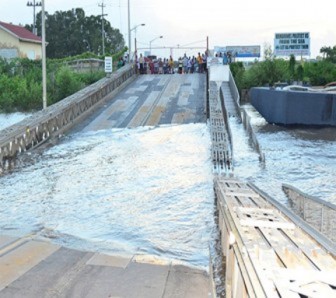A pre-feasibility study for replacing the Demerara Harbour Bridge (DHB) – which continues to be plagued by mechanical problems as it nears the end of its lifespan — is expected to be ready by year end, according to Cabinet Secretary Dr Roger Luncheon.
Luncheon said last Thursday that the pre-feasibility study will be ready in another four months that would examine the viability of an underground tunnel, an above ground fixed bridge or another floating bridge.
The growth in traffic between the two sides of the Demerara River, he noted, has taken a toll on the bridge, which opened in 1978 and has been the major artery on the Demerara River. State-owned ferries ceased working on the river several years ago and its means that commuters today have to rely solely on speed boats.

On July 23, a section of the bridge collapsed after the jaws of one of the piers supporting two temporary pontoons at span 61 broke. Traffic across the bridge was interrupted for nearly two days before repairs were properly completed.
Luncheon said a similar incident would expose the lack of an alternative, while adding that the DHB “looked barely pre-historic,” when compared with the technology of the Berbice River Bridge.
In the interim, he added, the government will actively pursue the improvement in the stellings on both sides of the Demerara River to facilitate pontoons to allow travel by the commuters who use minibuses as well as motorists.
With millions spent each year on the continuous maintenance of the bridge, APNU MP and Shadow Public Works Minister Joseph Harmon told this newspaper that a viable option in the form of a fixed high bridge is needed to link the regions 3 and 4. He said that there is a growth in economic activity along both banks of the river, while adding that any plans for construction of a new structure would require broad consultation from residents on both sides of the river.
The current state of the harbour leaves much to be desired, Harmon noted. ”What is happening now is that we are doing patch work to keep it in place… it has really gone beyond the useful life,” he said.
Harmon, who said a model for a fixed bridge can be found in neighbouring Suriname. He said it would require urban restructuring on both sides of the river, while adding that development of Region Three demands a structure that is more reliable and sturdy.
‘Expertise needed’
Meanwhile, Stabroek News spoke with an experienced engineer, who asked not to be named, and he said the yearly maintenance cost for the current bridge will only increase and when combined with the reality of the traffic demands, maintenance is uneconomical and the structure is dangerous. “So there is no need for a feasibility study,” he added. The funds being spent to maintain the current structure, he said, could be invested in a new one.
He said that it is important to note that when the bridge was built in
1978, it was mainly to accommodate free moving traffic, not bumper-to-bumper consistent traffic which creates more weight on the bridge. “Weight poses a risk at this point, more so constantly,” he added.
He is of the opinion that a new bridge can be built in the vicinity of the bridge or anywhere further up the East Bank of Demerara.
A fixed bridge is the more viable option for the area, he said, while noting that the actual cost cannot be determined until after the design phase.
According to the engineer, geo-technical studies and designs for a new structure will take some three to four months and actual construction of a new structure would take approximately one year.
As regards who should build the new structure, the engineer bluntly noted, “certainly not a local one.”
“We don’t have the necessary skilled expertise needed… our engineers learn hands-on and are taught from outdated books. What we can have is our leaders negotiating so that there are personnel from local engineering companies on site so they acquire knowledge,” he explained.
In recent times, government has turned to expertise from China to carry out critical projects but according to the engineer, consideration should be given to a specialised company. ”The Chinese have great knowledge in building sturdy and state-of-the-art bridges but you have to get a company who is specialised in that kind of thing,” he said. He added that the Chinese can carry out high-cost government projects but he noted that there should be proper due diligence on the best contractor. “I personally do not feel… we should go engaging the first Chinese company that approaches us with what we feel is a good deal. First, get expert advice and consultations before moving ahead,” he said, while adding that “this is not a Robeson Benn Bridge its Guyana’s Bridge.”
The floating steel structure, which measures 6074 ft (1851.4 metres), spans the Demerara River from the village of Peter’s Hall on the eastern side to Plantation Meer-Zorgen on the western end.
The bridge consists of 61 spans of varying lengths and floats on 122 steel pontoons. It was acquired and constructed during the period 1976-1978, finally opening to the public on July 2, 1978.
The bridges’ fruition as an economic link was the focus of two pre-feasibility foreign studies, which looked at the transport sector in the country in the 1970s.




